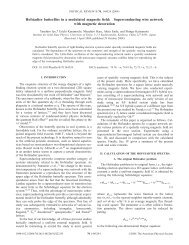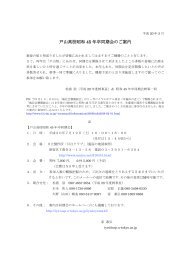Spin-flip Process and Quantum Decoherence in a Quantum Dot
Spin-flip Process and Quantum Decoherence in a Quantum Dot
Spin-flip Process and Quantum Decoherence in a Quantum Dot
You also want an ePaper? Increase the reach of your titles
YUMPU automatically turns print PDFs into web optimized ePapers that Google loves.
<strong>Sp<strong>in</strong></strong>-<strong>flip</strong> <strong>Process</strong> <strong>and</strong> <strong>Quantum</strong> <strong>Decoherence</strong> <strong>in</strong> a <strong>Quantum</strong> <strong>Dot</strong>Hisashi Aikawa 1 , Kensuke Kobayashi, Akira Sano, Sh<strong>in</strong>go Katsumoto <strong>and</strong> Yasuhiro IyeInstitute for Solid State Physics, University of Tokyo, Kashiwa, Chiba 277-8581, JapanAbstractWe studied coherence of electrons travers<strong>in</strong>g a quantum dot (QD) by us<strong>in</strong>g an Aharonov-Bohm (AB) <strong>in</strong>terferometer. Itwas found that for the so-called “sp<strong>in</strong>-pair” peaks of Coulomb oscillations the amplitude of the AB oscillation is differentbetween one <strong>and</strong> the other side of each peaks <strong>and</strong> that the amplitude is smaller for the sides fac<strong>in</strong>g with each other than theouter ones. Similar result was obta<strong>in</strong>ed for a QD <strong>in</strong> the Kondo state. These observations agree with the theoretical modelthat relates a sp<strong>in</strong>-<strong>flip</strong> process of travers<strong>in</strong>g electrons through a QD to the decoherence.Key words: Aharonov-Bohm effect, quantum dot, sp<strong>in</strong>-<strong>flip</strong> process, decoherencePACS: 73.21.La, 73.23.Hk, 72.15.Qm1. Introduction<strong>Quantum</strong> coherence of electrons plays a centralrole <strong>in</strong> mesoscopic transport phenomena such as weaklocalization, universal conductance fluctuation, <strong>and</strong>Aharonov-Bohm (AB) effect [1]. So the underst<strong>and</strong><strong>in</strong>gof microscopic mechanisms that degrade quantumcoherence has been a significant issue not only for fundamentalphysics but also for challenges to quantumdevices. Coherent transport through a quantum dot(QD) embedded <strong>in</strong> one of arms of an AB r<strong>in</strong>g givesan optimal experimental stage to explore quantumcoherence associated with a s<strong>in</strong>gle tunable scatterer.Such a system has been studied for several years,<strong>and</strong> it is known that the coherence survives throughQDs [2–6]. In terms of quantum decoherence, currentflow<strong>in</strong>g a quantum po<strong>in</strong>t contact coupled to a QD wasproved to deteriorate <strong>in</strong>terference signal by measur<strong>in</strong>g“which-path” an electron passed [7].1 Correspond<strong>in</strong>g author. E-mail: astar@issp.u-tokyo.ac.jpIn this paper, we present an experiment focus<strong>in</strong>g onan <strong>in</strong>fluence of the sp<strong>in</strong> degree of freedom <strong>in</strong> a QD onthe AB <strong>in</strong>terference [8,9]. We consider the simplest situationwhere sp<strong>in</strong>-degenerate s<strong>in</strong>gle-particle levels distributewith an equal spac<strong>in</strong>g <strong>in</strong> a QD. When the numberof electrons <strong>in</strong> the QD is odd, the topmost levelhas an excess electron, say with sp<strong>in</strong>-up, as depicted<strong>in</strong> Fig. 1(a). After an electron with down-sp<strong>in</strong> enterthe QD, there arises two possibilities for the QD to letgo of an electron (Fig. 1(b)). If the up-sp<strong>in</strong> electrongoes away from the QD (Fig. 1(c)), coherence will belost s<strong>in</strong>ce it leaves “traces” <strong>in</strong> the QD, so the <strong>in</strong>terferenceeffect is degraded. This process is the most primitivecase of quantum decoherence caused by sp<strong>in</strong> scatter<strong>in</strong>g.Because this occurs only when the number ofelectrons <strong>in</strong> the QD is odd [8,9], the <strong>in</strong>terference signalshould be reduced at sides of a Coulomb oscillationpeak fac<strong>in</strong>g the Coulomb blockade valley of odd numberof electrons, produc<strong>in</strong>g an asymmetry of coherencefor one Coulomb peak <strong>and</strong> its an even-odd behavior forsuccessive Coulomb peaks (Fig. 1(d)).Prepr<strong>in</strong>t submitted to Physica E 6 June 2003
(a)(d)3. Results <strong>and</strong> discussions(b)(c)SG(e)1 µmV gL L S S L Leven odd evenV gcontrol gateQDFig. 1. (a), (b), <strong>and</strong> (c) Schematic draw<strong>in</strong>gs of energy diagramof a QD <strong>and</strong> the dephas<strong>in</strong>g process of a travers<strong>in</strong>gelectron by <strong>flip</strong>p<strong>in</strong>g its sp<strong>in</strong>. (d) Illustration of Coulombpeaks <strong>and</strong> the expected magnitude of AB <strong>in</strong>terference signal<strong>in</strong>dicated by letters “L” (large) <strong>and</strong> “S” (small). Becausethe parity of the number of electrons <strong>in</strong> the QD changes byturns for successive Coulomb peaks as chang<strong>in</strong>g the gatevoltage V g, the direction of the asymmetry changes alternately.(e) Scann<strong>in</strong>g electron micrograph that has the samegeometry with measured sample.2. ExperimentWe prepared a QD-AB-r<strong>in</strong>g system fabricated on atwo-dimensional electron gas (mobility 90 m 2 /Vs <strong>and</strong>sheet carrier density 3.8× 10 15 m −2 ) <strong>in</strong> GaAs/AlGaAsheterostructure by us<strong>in</strong>g electron beam lithography,wet etch<strong>in</strong>g <strong>and</strong> vapor deposition of metallic gates(Fig. 1(e)). A QD was formed <strong>in</strong> the lower arm of theAB r<strong>in</strong>g by negatively bias<strong>in</strong>g both sides of the threegates, the middle one (V g) was used to control the electrostaticpotential of the QD, <strong>and</strong> the one of the uppergates was used to tune the transmission bypass<strong>in</strong>g theQD. The sample was cooled <strong>in</strong> a dilution refrigeratorwith base temperature of 30 mK <strong>and</strong> was measuredby st<strong>and</strong>ard lock-<strong>in</strong> technique (80 Hz frequency <strong>and</strong>10 µV excitation voltage) <strong>in</strong> the two-term<strong>in</strong>al setup.A superconduct<strong>in</strong>g solenoid was used to apply themagnetic field (B) perpendicular to the sample.SSuccessive occupation of a sp<strong>in</strong>-degenerate level <strong>in</strong> aQD by up-sp<strong>in</strong> <strong>and</strong> down-sp<strong>in</strong> electrons, which is theunderly<strong>in</strong>g assumption for the even-odd behavior of theasymmetry, is known to occur rarely <strong>in</strong> semiconductorQDs [10–12]. Therefore, it is necessary firstly to searchfor ideal condition, a so-called “sp<strong>in</strong>-pair” state, whichcan be found by observ<strong>in</strong>g the B-dependence of position<strong>and</strong> height of Coulomb peaks; a sp<strong>in</strong>-pair appearsas a pair of adjacent peaks with the same variation <strong>in</strong>their position <strong>and</strong> height as a function of B becausethey belong to the same orbital state.We measured the Coulomb oscillations as sweep<strong>in</strong>gV g at fixed B’s. The parametric variations ofthe position <strong>and</strong> height of n<strong>in</strong>e successive Coulombpeaks as a function of B are summarized <strong>in</strong> Figs. 2(a) <strong>and</strong> (b), respectively. These were obta<strong>in</strong>ed byfitt<strong>in</strong>g each Coulomb peak to the conductance formG h cosh −2 ((V g − V p)/w)+G ref where G h , V p, w, <strong>and</strong>G ref are the peak height, peak position, the peak width<strong>in</strong> unit of V g, <strong>and</strong> the conductance of the referencearm, respectively. As seen <strong>in</strong> Figs. 2(a) <strong>and</strong> (b), thebehaviors of the peak 5 <strong>and</strong> the peak 6 are correlatedfar better than the other sets of peaks, <strong>in</strong>dicat<strong>in</strong>g thatthese two are a sp<strong>in</strong>-pair <strong>in</strong> this range of B. The smallpeak spac<strong>in</strong>g between them (see Fig. 2 (a)) also agreeswith the <strong>in</strong>tuition that the addition energy is smallfor successive occupation of the same energy level becauseit does not require level spac<strong>in</strong>g energy to putan electron.For more quantitative analysis, we calculated thest<strong>and</strong>ard deviation of peak spac<strong>in</strong>g (∆V p) fromFig. 2(a) <strong>and</strong> the root-mean-square (rms) value ofdifference of neighbor<strong>in</strong>g peak height (∆G h ) fromFig. 2(b), <strong>and</strong> they are plotted <strong>in</strong> Fig. 2(c) as thevertical <strong>and</strong> the horizontal axes, respectively. Becauseboth of them are expected to be simultaneously smallfor the sp<strong>in</strong>-paired peaks, we conclude that the peak5 <strong>and</strong> the peak 6 orig<strong>in</strong>ate from a sp<strong>in</strong>-pair state.We note that the presence of such sp<strong>in</strong>-pair peaks isscarce as reported previously [12] <strong>and</strong> the typical ratioof f<strong>in</strong>d<strong>in</strong>g a sp<strong>in</strong>-paired peak out of all the Coulombpeaks is less than 10 %.Next, we measured the AB oscillations as sweep<strong>in</strong>gB at fixed V g’s to get the magnitude of coherence ofthe sp<strong>in</strong>-pair peaks 5 <strong>and</strong> 6 <strong>in</strong> Fig. 2. Figure 3(a) is2
Peak Position V p(V)SD (∆V p) (mV)-0.10-0.15-0.20-0.25165430.3(a)0.4B (T)9876543210.50.15 (e 2 /h)Peak Height G h0.3(b)0.4B (T)(c) 3-4 4-52-35-67-86-71-20.01 2x10 -2 3 4 5 6RMS (∆G h) (e 2 /h)Fig. 2. Magnetic field dependence of (a) position <strong>and</strong> (b)height of n<strong>in</strong>e successive Coulomb peaks as a function of B.The peaks are numbered as shown <strong>in</strong> the plot. (c) St<strong>and</strong>arddeviation (SD) of the difference of peak position (∆V p)<strong>in</strong>(a) is plotted aga<strong>in</strong>st the root mean square (RMS) valueof the difference of peak height (∆G h ) <strong>in</strong> (b). Because thepo<strong>in</strong>ts closer to the orig<strong>in</strong> <strong>in</strong>dicate higher correlation betweenthe peaks, we can regard the peak 5 <strong>and</strong> 6 as asp<strong>in</strong>-pair peak as well as from the small peak spac<strong>in</strong>g <strong>in</strong> (a).a gray-scale plot of the extracted AB component byus<strong>in</strong>g fast Fourier transform as a function of V g <strong>and</strong>B. The vertical l<strong>in</strong>es <strong>in</strong>dicate the peak positions. Thephase of the AB oscillation shows abrupt change by πnear each Coulomb peak, reflect<strong>in</strong>g the two-term<strong>in</strong>alsetup of our measurement [13,14]. In Fig. 3(b), we plotthe amplitude of the AB oscillation averaged over tenAB periods around B =0.485 T as a function of V g.We selected the field range where the peak positiondoes not shift largely as sweep<strong>in</strong>g B. The dip <strong>in</strong> the ABamplitude at the peak position is due to the phase jumpof the AB oscillation. Therefore, the data can be viewedthat the averaged AB amplitude for one Coulomb peakis composed of of two sub-peaks with a dip <strong>in</strong> between.The po<strong>in</strong>t is that the two sub-peaks compos<strong>in</strong>g theAB amplitude for one Coulomb peak are different <strong>in</strong>8-90.5987654321B (T)AB Amp. (e 2 /h)0.500.490.48(a)peak5peak68x10 -3 (b)6420-0.19 -0.18 -0.17V g(V)0.020.00-0.02Fig. 3. (a) Gray-scale plot of the AB oscillation componentfor the sp<strong>in</strong>-pair peaks <strong>in</strong> Fig. 3 aga<strong>in</strong>st the gate voltage V g<strong>and</strong> the magnetic field B. (b) Averaged amplitude of theAB oscillation measured at each V g. Vertical l<strong>in</strong>es representthe center of the Coulomb oscillation peaks where the πphase jump degrades the AB amplitude <strong>in</strong> our two-term<strong>in</strong>alsetup. The AB amplitude is asymmetric with respect to thecenter of the peak.its height, show<strong>in</strong>g the asymmetry of the <strong>in</strong>terferencesignal. Moreover, the direction of the asymmetry isreversed between the adjacent sp<strong>in</strong>-paired Coulombpeaks as is expected from the successive occupation ofa sp<strong>in</strong>-degenerate level as depicted <strong>in</strong> Fig. 1(d). Theseresults st<strong>and</strong> for the predicted effect of sp<strong>in</strong>-<strong>flip</strong> processon the coherence.Another evidence was obta<strong>in</strong>ed from a measurementwhen the Kondo effect appears. Because ord<strong>in</strong>aryKondo effect emerges from sp<strong>in</strong>-<strong>flip</strong> scatter<strong>in</strong>g, theconditions for sp<strong>in</strong>-<strong>flip</strong> process should be fulfilled <strong>in</strong>Kondo valleys. Figures. 4(a) <strong>and</strong> (b) show the temperature<strong>and</strong> the bias-voltage dependence of the QD withthe reference arm closed, respectively. From analysessimilar to the reported one [4,15], we f<strong>in</strong>d the temperaturedependence is consistent with the Kondo effectfor the QD with sp<strong>in</strong> 1/2 <strong>and</strong> the Kondo temperatureis estimated to be T K ∼ 450 mK at the middle of thevalley. This result guarantees that a sp<strong>in</strong>-pair stateexists <strong>in</strong> this energy range <strong>and</strong> works as the source ofthe Kondo effect.Next, we opened the reference arm <strong>and</strong> measured theAB oscillation. In Fig. 4(c), we plotted the averagedconductance (•) <strong>and</strong> AB amplitude (◦) as a function ofV g. Except for the absence of the dip structure at theconductance peak because of the unique phase shift forthe Kondo QD, we found qualitatively the same resultAB Osc. (e 2 /h)3
V g(V)G (e 2 /h)-0.94(b)-0.96-0.98G (e 2 /h)1.00.50.02.01.91.81.7(a)-0.98 -0.96 -0.94V g(V)-0.5 0.0 0.5V sd(mV)(c)-0.98 -0.96 -0.94V g(V)B = 0.55 T30 mK0.55 T0.80.60.40.020.010.0030 mK150200300500800G (e 2 /h)AB Amp. (e 2 /h)Fig. 4. (a) Temperature dependence <strong>and</strong> (b) bias-voltagedependence of the Coulomb oscillation with the other armof the r<strong>in</strong>g was p<strong>in</strong>ched off, both show<strong>in</strong>g clear sign ofthe Kondo effect. White arrow <strong>in</strong> (b) <strong>in</strong>dicates the Kondoresonance at zero bias. (c) Measured conductance (filledcircle) <strong>and</strong> AB amplitude (open circle) averaged betweenB =0.525 T <strong>and</strong> B =0.585 T are plotted aga<strong>in</strong>st V g. Thevertical l<strong>in</strong>es are drawn along the conductance peaks.on the sp<strong>in</strong>-pair peaks; the AB amplitude is reducedat the Kondo valley, yield<strong>in</strong>g the asymmetry of the<strong>in</strong>terference signal <strong>and</strong> its even-odd behavior.4. ConclusionIn conclusion, we observed the asymmetry of the AB<strong>in</strong>terference signal through a QD with respect to thecenter of the Coulomb peak. The measurement on thesp<strong>in</strong>-pair peak <strong>and</strong> the Kondo QD <strong>in</strong>dicate that thesp<strong>in</strong>-<strong>flip</strong> process <strong>in</strong> the QD is a possible cause of excessdephas<strong>in</strong>g. The present study is the first experimentaldemonstration that the <strong>in</strong>terference effect through as<strong>in</strong>gle scatterer is reduced depend<strong>in</strong>g on its sp<strong>in</strong> state,which is a microscopic <strong>and</strong> fundamental process of sp<strong>in</strong>scatter<strong>in</strong>g<strong>in</strong>duced quantum decoherence.AcknowledgementsWe thank K. Enssl<strong>in</strong>, Y. Gefen, <strong>and</strong> J. König forhelpful discussion. This work is supported by a Grant<strong>in</strong>-Aidfor Scientific Research <strong>and</strong> by a Grant-<strong>in</strong>-Aid forCOE Research (“<strong>Quantum</strong> <strong>Dot</strong> <strong>and</strong> Its Application”)from the M<strong>in</strong>istry of Education, Culture, Sports, Science,<strong>and</strong> Technology of Japan.References[1] Y. Aharonov <strong>and</strong> D. Bohm, Phys. Rev. 115, 485(1963).[2] A. Yacoby, M. Heiblum, D. Mahalu, <strong>and</strong> H. Shtrikman,Phys. Rev. Lett. 74, 4047 (1995).[3] R. Schuster, E. Buks, M. Heiblum, D. Mahalu,V. Umansky, <strong>and</strong> H. Shtrikman, Nature 385, 417(1997).[4] W. G. van der Wiel, S. De Franceschi, T. Fujisawa,J. M. Elzerman, S. Tarucha, <strong>and</strong> L. P. Kouwenhoven,Science 289, 2105 (2000).[5] Y. Ji, M. Heiblum, D. Spr<strong>in</strong>zak, D. Mahalu, <strong>and</strong>H. Shtrikman, Science 290, 779 (2000); Y. Ji,M. Heiblum, <strong>and</strong> H. Shtrikman, Phys. Rev. Lett. 88,076601 (2002).[6] K. Kobayashi, H. Aikawa, S. Katsumoto, <strong>and</strong> Y. Iye,Phys. Rev. Lett. 88, 256806 (2002).[7] E. Buks, R. Schuster, M. Heiblum, D. Mahalu, <strong>and</strong>V. Umansky, Nature 391, 871 (1998).[8] H. Akera, Phys. Rev. B 47, 6835 (1993); H. Akera,Phys. Rev. B 59, 9802 (1999).[9] J. König <strong>and</strong> Y. Gefen, Phys. Rev. Lett. 86, 3855(2001); J. König <strong>and</strong> Y. Gefen, Phys. Rev. B 65, 045316(2002).[10] S. R. Patel et al., Phys. Rev. Lett. 80, 4522 (1998).[11] S. Lüscher, T. He<strong>in</strong>zel, K. Enssl<strong>in</strong>, W. Wegscheider,<strong>and</strong> M. Bichler, Phys. Rev. Lett. 86, 2118 (2001).[12] S. L<strong>in</strong>demann, T. Ihn, T. He<strong>in</strong>zel, W. Zwerger, <strong>and</strong>K. Enssl<strong>in</strong>, Phys. Rev. B 66, 195314 (2002).[13] A. Levy Yeyati <strong>and</strong> M. Buttiker, Phys. Rev. B 52,R14360 (1995).[14] A. Yacoby, R. Schuster, <strong>and</strong> M. Heiblum, Phys. Rev.B 53, 9583 (1996).[15] D. Goldhaber-Gordon, J. Göres, M. A. Kastner,H. Shtrikman, D. Mahalu, <strong>and</strong> U. Meirav, Phys. Rev.Lett. 81, 5225 (1998).4








